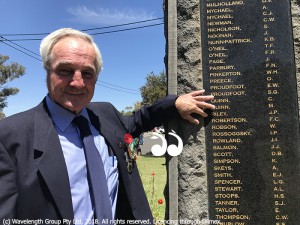Two Brothers Remembered
Jack and Percy Riley from Stewarts Brook were only two kilometres apart on the Western Front when they were injured within two days of each other.
Bruce Brown, a veteran of Vietnam, told the story of his great-uncles during the commemorative service of Armistice Day in Scone:

Bruce Brown remembered his great uncle James Percy Riley, from Stewarts Brook, who fought on the western front.
Both Percy and Jack Riley were on active service at the Battle of Amiens on August 8, 1918 although they were unaware they were both so close.
Percy Riley was in the 35th Battalion, 9th Brigade, 3rd Division and Jack Riley was in the 4th Battalion, 12th Brigade, 4th Division.
The Battle of Amiens map shows the location of the 9th and the 12th Brigades located just to the south of Hamel village and next to each other on the map.
Also the 3rd and 4th Division command locations to the west of Hamel village. Both the Brigades would have been within a kilometre or so of each other.
So it is unfortunate that the brothers never met in 1918 and never saw each other again.
James Percy Riley enlisted in April 1916 and arrived in France on October 22, 1016 with the 36th Battalion, 9th Brigade of the 3rd Division. in late November 1916 the 36th Battalion moved into the trenches of the western front in northern France just before winter of 1916-17. On February 18, 1917, he was wounded in the back and evacuated to England.
On August 24, 1917 he returned to the 36th Battalion located on Ypes Salient sector of Belgium and in October fought in the Battle of Passchendaele.
From November 1917 until March 1918 the 36th Battalion alternated between periods of rest, training, labouring and service on the western line and in March 1918 moved south to the Somme River and was deployed to defence the approaches to Amiens around Villers Bretonneux, it helped defeat a major drive on Villers Bretonneux on April 4, 1918.
The 36th Battalion was disbanded on April 30, due to heavy losses in the 3rd Division, so that other Battalions could be reinforced.
On April 30, James Percy Riley transferred to the 35th Battalion, 3rd Division. On August 8, the 35th Battalion took part in the battle of Amiens and fought several other battles during the rapid advance of the allies that followed.
On August 24 he was wounded, with a gunshot to the left thigh and was evacuated to Oxford, England. He died on September 11, 1918 at the Southern General Hospital in Oxford after an operation and the amputation of his left leg. James Percy Riley is buried at Botley Cemetery Oxford.
John Hampton Riley, uncle Jack, enlisted on May 8, 1917 and departed Australia on October 31 in the 3rd Battalion. He arrived in England in December 1917 where he stayed until he departed for France in 1918.
Jack Riley arrived in France on June 24, 1918 and was taken on strength on July 3, 1918 in the 45th Battalion. On August 8, the 45th Division was involved in the allied counter offensive at the battle of Amiens. On the first day of this battle his Battalion captured 400 German prisoners, 30 artillery pieces and 18 machine guns. August 8 became known as the “blackest day of the German army” and initiated a German retreat eastwards to the defensive barrier known as the Hinderburg line.
During August the Battalion moved east as the Germans retreated and on August 21 the 45th Battalion was located near Lihons, which is a small town located 20 kilometres east of Villers Betonneux.
Jack Riley was wounded on August 21 and evacuated to the Southern General Hospital at Birmingham, England. He was suffering debility and asthma and returned to Australia in February 1919 and discharged on March 13, 1919.
Although injured in August his family was unaware where he was or how badly injured until his father expressed concern about his state of health and whereabouts in December 1918. He also wished to advise him of Percy’s death.
 scone.com.au
scone.com.au